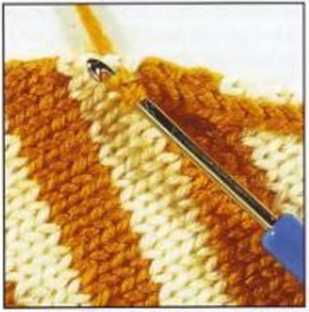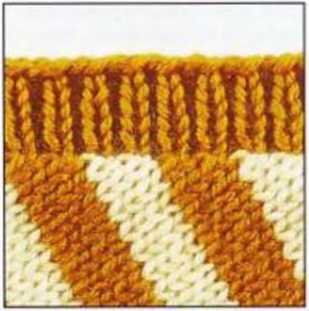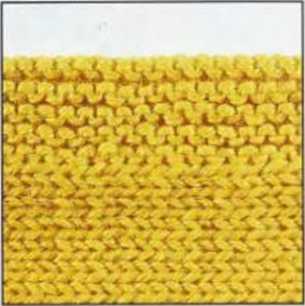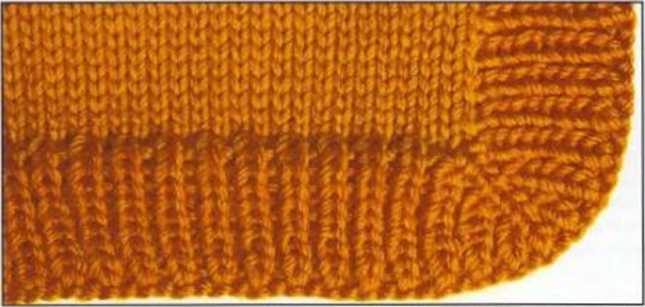063


For pieces knit on the diagonal. a facing is easier to work and also morę anractive if you crochet a slip stitch through every row along the edge. _

Then work a stitch out of every slip stitch, catching both parts of the stitch. For this facing, the stitches were pickod up from the front,...
Knit-on Facings

...and for this facing, they were picked up from the back. Here the slip-stitch edge makes a nice transition.

For this garter-stitch facing, the stitches are bound off in a row on the wrong side of the work as knit stitches.


Binding off stitches that are too loose or irregular can he ąuickly and easily corrected (see page 451.
Worked around the corner: If
facings are supposed to be worked all around, stitches have to be in-creased at all the corners. These increases turn out best with yarn overs purled twisted. At every corner, knit an additional knit stitch out of the corner edge stitches. On both sides of this stitch, the increases are madę alternately with
a twisted knit stitch and a twisted purl stitch. In order to get a nice angle, 2 rows with increases and 1 row without increases have to be worked alternately. For knit increases, make surę that the ap-pearance is symmetrical (see sym-metrical increases with yarn over, page 401. Bind the stitches off after the desired length is reochod.
63
Wyszukiwarka
Podobne podstrony:
APPENDIX B RECOMMENDED STANDARD FOR DYNAMIC PROBING 1. SCOPE The expression probing is used to indic
UHAM018 Headache or migraine, acute or chronię? Most of the time, it is possible to work out whether
107 X The United States is prepared to accept and act in accordance with the balances of interests r
232 (62) 203Mounts Presumably a mount, though the lentoid section is easier to parallel among la ter
8 The noxt stitch is a knit stitch of tho stitch, from right to left. and and is twisted on the need
steering lock FEATURES(Not required for operation) STEERING LOCK The steering lock (1) is on the ste
ape 013 *3 RESULTS OF PHYSICAL TRAININC. all on the will. This is vcry natura), for in all muscular
00210 ?246880ef8acb759604ec0c539ba3cf 212 Messina, Montgomery, Keats & Runger EWMA and tracking
00343 ?2133ef95cf1f1920885bd442e7266a 347 A Monitoring Plan for Detecting Product Degradation check
New Kids On The Block Greatest Hits(inside3) 198L as »as the dizzying breakthrough year for New Kids
The following presentation is going to concentrate mainly on the issue of defining what is meant by
INFOST XXX Page 4 of 7 ASSIGNMENTS: Assignments are due on the specified datę (midnight CST on the d
image015 Audio Options for Speakers Soundcard Device Please select the device that is attached to yo
45 (33) The grizzly bear is ready to get some rest in his den. Find the path for him to follow to re
więcej podobnych podstron